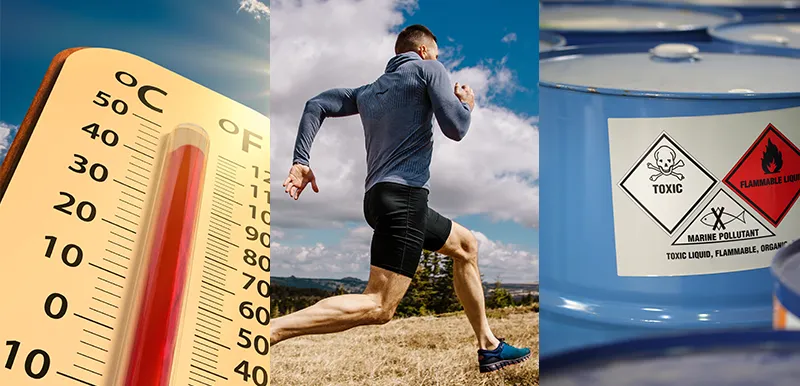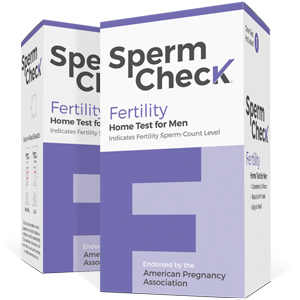
As a man, there are many different aspects of your life that you can alter if you’re focused on improving fertility, including:
- Environmental Aspects (Exposure to Heat and/or Chemicals)
- Mental Aspects (Sleep, Stress, Mental Health)
- Physical Aspects (Diet, Exercise, Etc.)
Here, you will learn about the many different environmental aspects of your life that can affect male fertility. In addition to limiting excessive heat and managing chemical exposure, you can gain an understanding of prevalent male fertility concerns and the criteria used to determine what is considered within the normal range.
Essential Parameters for Male Infertility
Two in every one hundred men will exhibit less-than-ideal sperm parameters. These parameters are typically measured by looking at a man’s sperm count, sperm morphology, and sperm motility.
Sperm Count
Sperm count is the number of sperm in a single ejaculate. Fertility experts measure sperm count in millions of sperm per milliliter (mL) of semen. An average sperm count is 15 million sperm per mL or more; anything less than 15 million sperm per mL would be considered a low sperm count.
Sperm Morphology
A sperm’s morphology (shape) is a crucial metric to understand when assessing male fertility. Abnormally shaped sperm are less likely to have the ability to swim and penetrate an egg’s outer layer; both functions are necessary for fertilization. The more normally-shaped sperm a man has, the more likely those sperm can fertilize an egg.
Sperm Motility
Sperm motility describes how well sperm can move. If a man has normal sperm motility, his sperm moves through the female reproductive tract to reach an egg within the normal timeline (up to 12 hours after ejaculation). If a man has low sperm motility, his sperm does not move fast enough or far enough to fertilize an egg.
Improving Male Fertility by Avoiding Heat
The scrotum houses the testes and controls the temperature for optimal sperm production. It is designed to keep the testes slightly cooler than the body’s core temperature, which is why they are external sex organs. This difference in temperature that is assured by an exterior “housing” for the testes is essential for producing healthy sperm.
Prolonged exposure to high heat can damage sperm, reducing sperm motility and viability. Some examples of prolonged heat exposure include:
- Jacuzzis
- Saunas
- Hot Baths/Showers
- And More
Practical Ways to Minimize Heat Exposure
To improve sperm health, aim to minimize unnecessary exposure to high heat. Some practical steps include:
- Limiting your use of jacuzzis, saunas, and hot baths/showers.
- Avoiding using heated car seats for extended periods.
- Avoiding long-term use of heated pads and heated blankets,
- Taking breaks during physical exertion and allowing the body to cool down.
- Limiting the use of laptops directly on the lap, especially for extended amounts of time.
Improving Male Fertility by Avoiding Chemicals
A growing body of evidence suggests that exposure to certain chemicals may affect male fertility. These chemicals can interfere with many different aspects of sperm health, including sperm count, morphology, motility, and more. Some common chemicals and other environmental culprits that can hinder male fertility include:
| Environmental Exposure | Impact on Fertility |
| Pesticides/Herbicides (DST, DBCP, Organophosphates, Atrazine) | Reduced sperm count, motility, viability, concentration, morphology, and increased DNA damage. |
| Bisphenol A (BPA Plastics) | Reduced sperm concentration, motility, and increased DNA damage. |
| Lead | Reduced sperm concentration, motility, and viability. |
| Natural Gas, Oil | Reduced sperm motility and increased DNA damage. |
| Radiofrequency Electromagnetic Radiation | Reduced sperm viability, motility, and increased DNA damage. |
Source: National Library of Medicine
Protecting yourself from harmful chemicals might seem daunting for some people, especially those in certain professions, but there are some practical steps you can take, including:
- Use personal protective equipment (PPE) when working with chemicals.
- Choose organic fruits and vegetables to limit exposure to pesticides and herbicides.
- Replace plastic containers and dinnerware with glass, aluminum, or other non-plastic materials to avoid chemicals leaching into food and water.
- Limit exposure to heavy metals like lead by avoiding high-risk environments.
- Always ventilate your space properly when using paints, varnishes, or other chemical substances.
Improving Male Fertility by Avoiding Certain Clothing
Sperm health can also be affected by the clothing a man chooses to wear. Tight underwear and pants increase the temperature of the scrotum, which – as noted above – may negatively impact sperm health.
For optimal sperm health, consider the following clothing choices:
- Opt for loose-fitting underwear and pants.
- Look for clothing made of natural fabrics like cotton, linen, and silk that allow for airflow and do not trap heat.
- Avoid keeping electronic devices that can generate heat (such as mobile phones) in your pockets for prolonged periods.
Note that while these tips can help protect and enhance male fertility, they are not guaranteed solutions. Age, genetics, and overall health also significantly affect male fertility. Always seek advice from healthcare professionals for personalized advice.
Struggling with infertility and need answers?
An at-home sperm test from SpermCheck can help you know your sperm levels and discover the best next step in your fertility journey. Order your SpermCheck Fertility test today.




